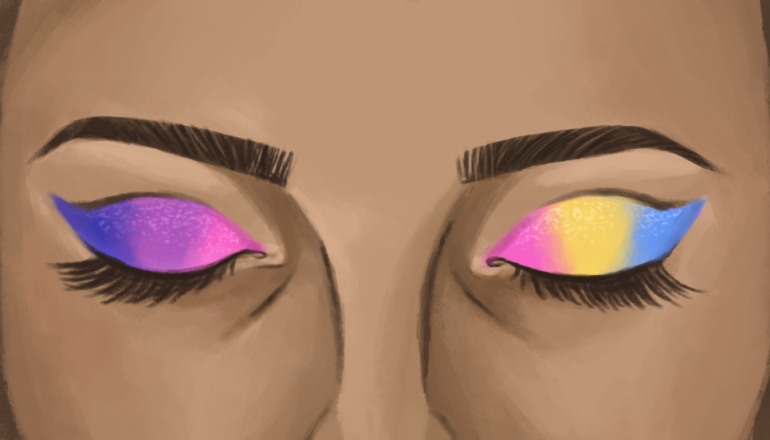Graphic by Hannah Boston
Bisexuality or pansexuality? For some, both identities essentially hold the same definition; for others, they are worlds apart. While both identities indicate an attraction to more than one gender, bisexuality is frequently generalized as attraction to two binary genders, whereas pansexuality is defined as attraction regardless of gender. The reality, however, is more complex and nuanced, and depends on each person’s individual definition of the terms, as well as on societal perception.
Andreas Kontonicolas, fifth-year Biomedical Sciences major, defines bisexuality as “the capacity to be attracted to genders like and unlike yourself, not necessarily at the same time and not necessarily to the same degree,” and pansexuality as “the capacity to feel attraction regardless of gender.”
To Sophie Gu, first-year English major, “the definition of being bi has been updated to reflect that you like the people of your gender and any other gender,” making it essentially interchangeable with pansexuality. For most UCLA students, it appears that although bisexuality and pansexuality are quite similar, pansexuality has the implication of a more fluid experience of sexuality.
Some people who experience multigender attraction opt to identify as bisexual due to the familiarity of the term. Esther Nikbin, second-year graduate Philosophy student who is “bisexual, but functionally pan,” states, it was “almost like a temporal thing for me, because when I was figuring stuff out, I didn’t really know so much about pansexuality; I just knew about being bi.” The bisexual label stuck, but she says that if she had figured out her sexuality earlier, she “would have just gone with pan.”
In addition to one’s personal familiarity with bisexuality, the term is more societally common as well. Sophie expresses that “it was easier to present… as [bisexual] and easier for other people to understand.” As bisexuality is more publicized as a sexuality than any other words for multigender attraction, most people will understand what it means immediately, requiring less emotional labor on the part of the person expressing their sexuality.
Others identify as bisexual because it is the label they find the most comfortable. Jasmin Gonzalez, first-year Biology major, says that while she identifies as bisexual, she does not “see it as strictly limiting” and would “still include non-binary people in there.” Nikbin points out that as bisexuality indicates an attraction to one or more genders, “you could be bisexual by being attracted to all not-men for instance, and then you’re not pan.”
For some, personal comfort with a label goes along with how that label is presented within society and the queer community. When Kontonicolas was “initially introduced to pansexuality on the internet, [they] disliked the way it was described… as a more ‘progressive’ version of bisexuality.” Since “switching labels would not remove the stigma and stereotypes associated with multisexuality,” they “kept the bisexual label out of a desire to prove people wrong.”
Despite pansexuality not working as a label for some, the term is beneficial to others because it gives them the language to explicitly express their attraction to all genders. Many who use it embrace the fluidity of the term and indicate an ability to be attracted to, fall in love with, and/or desire relationships or companionships with anyone, regardless of gender identity or anatomy. From a pansexual point of view, Rachel, a first year Undeclared Social Science major, defines herself as queer or pansexual because she “just love[s] people, and it’s always been about their heart rather than their gender.” She has felt obliged to use the term bisexual because “society doesn’t think pansexuality is a thing… People think if you use a label outside of LGBA [lesbian, gay, bisexual, asexual] you’re being too extra.” As pansexuality is a less-publicized sexuality, and not included in the commonly used acronym of LGBT, it is often erased. Rachel counters the assumption that pansexual people are “trying to act like we’re unique and special by refusing to conform” by asserting instead that “we’re just people who can like other people romantically and sexually.”
One reason that some choose to identify as pansexual is the assumption that bisexuality is inherently transphobic or exclusive of nonbinary genders due to the binary implications of the term. However, as language evolves to fit common needs, it can be argued that “bi” no longer restricts itself to two genders just due to the connotation of the language. While Nikbin has felt “to some degree anxious about calling [herself] bi due to the potential for nonbinary erasure,” she finds it “sort of contradictory to suggest that I’m erasing myself” as she is a transfeminine nonbinary person herself. She would like to debunk the notion that “bisexuality simply means attraction to men and women,” as this “overly simplifies it as a binarist notion… misrepresenting what bisexuality could mean.”
Meanwhile, pansexuality is also misconstrued. Gu mentions that “before bi became more inclusive as a term, pan seemed like a really good idea, but there is a lot of negative stigma about using new words to identify yourself.” She jokes that if you refer to yourself as pan, some people will ask if “you like cutlery.”
For people who are still questioning or figuring out their orientation, there is no need to worry. As Gonzalez explains, “if you’re just realizing that you’re not completely straight, just worry about accepting that before choosing a label. As long as you’re fine being who you are, then later on you can choose a label.”
Kontonicolas says, “be patient and kind to yourself… So many of us constantly interrogate ourselves and our attraction to people, trying to figure out what’s ‘genuine’ and what isn’t” as a result of being “socialized and conditioned since birth to see heterosexual attraction as the only legitimate form of attraction.”
“[There is no need to] make people exact the emotional labor out of you to like, explain exactly why you identify as whatever,” states Gu. “You’re experiencing the world as you.”

